Free Shipping on orders of $49+ | Signup for Direct Rewards
Free Shipping on orders of $49+ | Free Store Pickup | Signup for Direct Rewards
Free Shipping on orders of $49+ | Signup for Direct Rewards
Free Shipping on orders of $49+ | Free Store Pickup | Signup for Direct Rewards

Once you get into open water diving, it’s not long before you start hearing about wreck diving, cavern diving, technical diving, and eventually cave diving. If you’ve heard the allure of those dark tunnels and swam past the openings wondering what’s down there and how dangerous it really is…let’s go ahead and address it.
The majority of people participating in the sport do so quite successfully with the proper training and gear; however, this is an extreme sport and people die. On average, one person dies roughly every 3,286 dives with odds of survival increasing with experience and significantly decreasing with lack thereof. So if you’ve heard the call of the caves and are drawn to answer or are just curious what could possibly compel people to don what seems like a ridiculous amount of gear (all those tanks) and risk their lives, let’s explore.
Did you know that North Central Florida is one of the most popular areas for cave diving in the world? Just one of the main draws is Ginnie Springs with over 30,000 feet of underwater caves.
Check your air and let’s explore this labyrinth.
Quite simply, cave diving is technical scuba diving in underwater caves that are filled with…um…water. The purposes include exploration, scientific discovery, an extreme sport, and search and recovery. Due to the nature of these dives, they are considered technical penetration dives and are reserved for those with the proper skills, training, and gear.
Caves are overhead environments with no direct path to the surface, requiring you to navigate your way through naturally formed tunnels that twist and turn in the dark. Your only source of light is usually your dive lights, which you and your dive buddies brought along. And as you navigate the caves, you’re placing or following a guide line with directional line markers that leads you into and out of the complicated web. Add doing this all underwater and you’ve got an extreme sport that pushes your limits mentally and physically. Due to the environment, cave diving requires planning, research, and gear checks (including maintenance) prior to diving.
Still there? Mind the line and the markers. We’re just getting started.
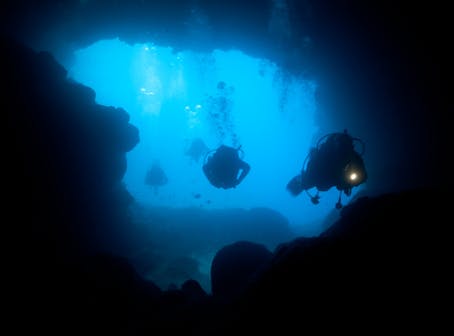

Diving in a cave means that you’re in an overhead environment and have no direct path to the surface and no view of sunlight. Caves usually involve a naturally formed complicated web of tunnels with varying widths and depths that you must navigate to explore and exit.
Caverns can be the entrance to a cave; however, the distinction is that you’re always able to see the opening of the cavern and natural sunlight. This distinction may vary based on where you are in the world; however, in all cavern diving, sunlight and the surface are quickly accessible without having to weave through a maze of tunnels.
Diving in caverns should precede cave diving and is highly recommended as you advance your training. Speaking of which, how’s your air? You ready to dive on?
As we’ve mentioned, this is an extreme sport that requires training, skills, mental acuity, and the right equipment. Did you know that more people have died exploring caves than have died on Mt. Everest? Yeah. And just like climbing Mt. Everst, it can be done. Safely. With the right gear and training.
Keep in mind that many cave divers have been diving for years safely and successfully. Take Jill Heinerth for example. A world renowned cave diver, she pushes limits in the name of exploration and scientific discovery. After all, being the first person to dive inside iceberg caves requires a certain level of training combined with nerves of steel.
Still with us? Check your breathing and air consumption then let’s round this next corner to explore another chamber.
Simply put, you’re in an underwater overhead environment with no direct access to the surface or natural light. This extreme sport requires you to navigate naturally formed twists and turns to wind your way back to the entrance (or sometimes further on to the exit) that at times can be a rather tight squeeze.
Getting lost, tangled in your line (or line left behind by previous explorers), running out of air, and getting stuck in a tight space all play into what makes cave diving more dangerous than open water scuba diving. Even the gear required to embark on a cave dive is more complicated and requires additional training. And since there is no natural light, you’re in a colder environment that can cause gear failure if you’re not using the right equipment.
Speaking of gear, how much battery do you have left in your dive light? Let’s head down the next arm of this labyrinth…
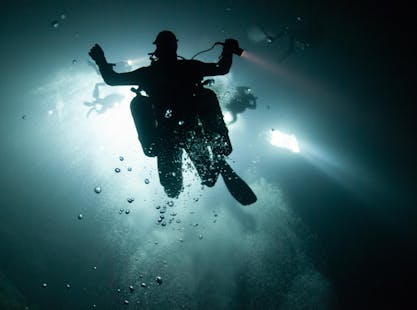
The number one reason cave divers die is simply lack of experience and training. All of the other reasons below are typically symptoms or the result of this underlying problem. Any cave diver who is diving beyond their skills, ability, experience, and training is putting themselves and everyone else in that cave at risk. Of course, we all make mistakes and unfortunately, mistakes while cave diving can turn fatal quickly.
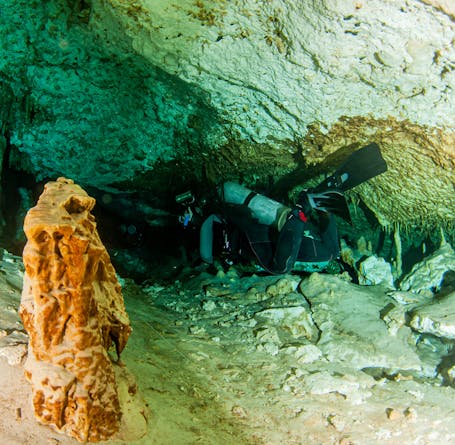
The simplest issue, which is easily avoidable yet happens, is mismanaging your air. We know, and…even experienced recreational divers with unobstructed access to the surface fall victim to running low or out of air because they were distracted or focusing on their dive. Training, including learning your rate of air consumption at different depths, temperatures, conditions, and in different environments, comes into play here. With this piece alone, experience is key. Refining your skills, knowing your gear, and knowing the specific environment you’re diving in are all important in successfully managing your air.
Not sure what we mean? Let’s dig in a bit. Say you drop in to dive and the current is pulling you along gently. You’re able to see everything and explore at will while exerting very little effort. Your air will last longer, you’ll explore farther, and you’ll see more than on another day when there is no current and you have to work, exerting energy and consuming more air, to explore and see anything. In the first scenario, your air may last 30 minutes, while in the second scenario it might last 20 minutes (or less). With just this one environmental change, if you’re determined to make it to the same point you did on the previous dive, you are potentially putting yourself in jeopardy and not allowing yourself the time to explore and enjoy the dive.
Remember that once the air is gone, there is nothing more that can be done.
Getting lost in a cave is another hazard that is usually avoidable. If you lose your way or visibility goes to crap, having the proper gear that is well maintained is often key here. Functioning dive lights (3), reels with lines (3), and line markers increase your odds of making it back out of the cave without getting lost; however, it is possible that those lines will become loose, break, or get fouled while on the dive. This is where your training, planning, and split second decisions make or break you.
The next hazard is that you’re diving in a natural overhead environment that is constantly changing. Water moves and tends to wear away structures, altering them so no two dives in an area are the same. Usually affecting small changes over time, as a cave diver you must always be aware that the ceiling, support structures, or any part thereof in the cave you’re diving may collapse at any moment.
Trapped in tight places as well as tangled in your line or line left behind by previous explorers are also very real dangers. Easily manageable, these scenarios demand that you remain calm, work through the solution (sometimes not trying to squeeze into a tight space is the answer), and reassess your dive. Panic and heavy breathing increases your air consumption thereby decreasing your time to figure your way out of the situation.
Unexpected current or current stronger than anticipated is another danger that is very real. As soon as you notice the current is different than anticipated, it’s time to assess whether it’s working for or against you for the duration of the dive. Make any adjustments necessary, and proceed as appropriate…which may mean cutting the dive and heading for the surface.
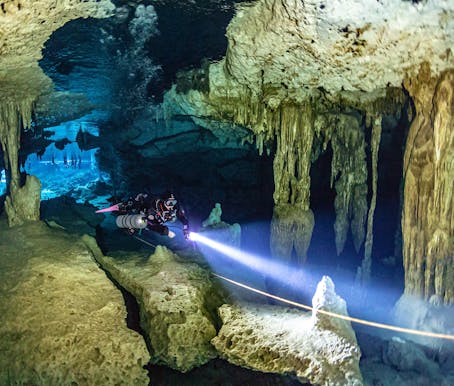
Gear failure is another issue for cave divers and is usually easily managed. Checking and maintaining your gear before and after each dive goes a long way to ensuring your cave dive is successful. Redundancies and backup gear help alleviate problems and give you time to correct an issue, make a decision, or figure out a solution while at depth.
With most of these situations, remaining calm and finding a solution is key to returning to the surface safely. Again, training, preparation, and the right dive gear will play a huge role in the success of your cave dive. And if you ever wondered why your dive instructor insisted you stay down and figure out the problem underwater, this right here is why. Surfacing when a problem arises isn’t always possible. Collecting yourself, remaining calm, and figuring out a solution at depth goes a long way to making it back to the surface to dive another day.
Ready for the next chamber? Take a minute, check your air, steel your nerves, and don’t forget to breathe.
It can be considered scary. But in our opinion, no. It really isn’t unless you’re afraid of the dark or uncomfortable in tight spaces - both very real fears that need to be considered before embarking on this journey.
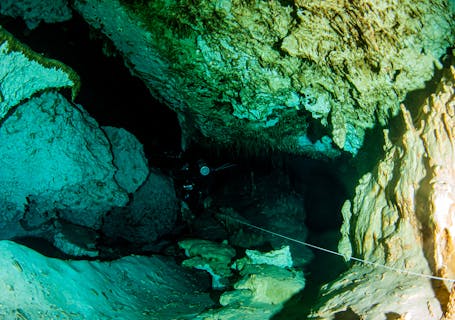
Cave diving is dark, your only light is delivered through your dive light (make sure your batteries are charged and you have at least two backups), and it can get to be rather tight quarters in places down there. You get a lot of alone time and you’ll learn a lot about yourself through your training and explorations. That can be scary, but then again…it can be very rewarding.
We’ve talked about the scariest situations above and other than that, the only thing left to be afraid of is exploring a place you’ve never been before. But that’s why we dive, isn’t it? The opportunity to explore places we’ve never seen and potentially discover and explore a place nobody has been before.
So…we’re moving on to the next section of this intricate system. Your buoyancy looks great and you’ve mastered that frog kick. Thanks for not kicking up any silt.
We are certain Jacques Cousteau faced similar questions as he explored the depths of the oceans. And the answers remain the same. Exploration, research, the mental and physical challenge, the thrill of the experience, seeing things that can’t be found anywhere else on earth, going somewhere nobody else has ever gone, and the list goes on.
The draw and allure of the dark depths is strong for those who have heard the call. Unavoidable even. And the ever-changing nature of these environments is part of the pull to return time and again to explore what’s changed and what has stayed the same. Similar to the reasons open water divers will dive the same site time after time. An explorer at heart, the pull is real and often stronger than a rip current.
Shall we keep moving forward?
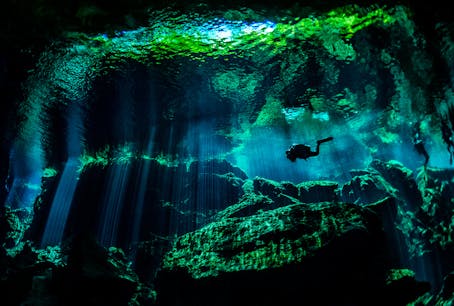
Breathing, staging, and decompression. Yes…from the beginning of your dive training you’ve been told to only do no-deco dives. You’ve been warned of the dangers of going into decompression on accident and if you didn’t plan for it, you’re in trouble.
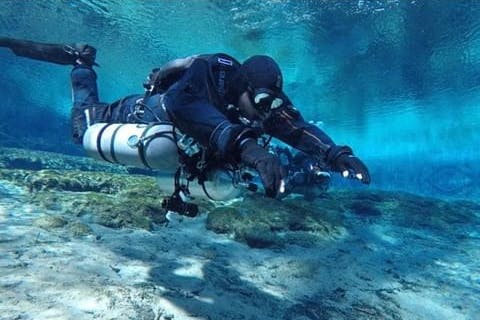
It’s time to start planning for it. When you start cave diving, you’re likely going to be doing decompression dives. That’s the nature of the type of dives you’re entering into. Cave dives require you to be underwater longer and usually at deeper depths than most recreational dives. Those two factors combined equal decompression dives. Which is why cave divers take along more scuba tanks than your average recreational diver.
Now all those scuba tanks don’t add up to the simple rule that more is better. The fact is that, unless you’re diving a rebreather, you typically breathe different mixes at different depths, so you’ve gotta take along tanks for each of your mixes. Additionally, this is your air supply and your time underwater is directly related to how much air (your chosen gas mix) you have. And you need enough air to manage your decompression stops.
Of course, the more you take along, the less streamlined and maneuverable you become…which is why many cave divers set up their scuba tanks in stages as they head into and move through a cave. It frees them up a bit and the air they need is right where they need it (as they retreat) when they need it.
You’re still there? Alrighty, let’s delve into this last area before following our line back to the surface through the maze.
The first step is to become a certified scuba diver by getting your Open Water certification. Next, you want to gain experience with diving. You’ll learn more on each dive and get your technique dialed in. Once you’ve got some experience, you’ll want to head into your Advanced Open Water certification and then delve into your Wreck diving certification (sometimes combined with Advanced Open Water). Did you get your Night diving certification yet? Caves are known to be a bit dark and you’ll need to know how to navigate in these conditions. It’s also a good idea to go ahead and start diving in low visibility conditions, you’re going to need to get comfortable with navigating when you can’t see much (or at all).
Now that you have all this training, and logged enough dives to dial in your skills and abilities in these environments, it’s time to get started on the real training. Yeah, you’re nowhere close to being ready to dive in caves yet. Reality check.
This is the time to check in and make sure you’re committed to cave diving. We mentioned training, and there are a lot of skills and knowledge you need to acquire and refine to embark on this journey; however, there’s a physical demand as well.
We’re certain you’ve heard that you need to be in good shape to dive. This is true with all diving and becomes more important when you’re headed into caves. Your habits on the surface will eventually play a role in your dives and when you’re cave diving, you need to be in the best shape possible. So take a minute to check in on your exercise routine, diet, and other habits that might inhibit your breathing rate, maneuverability, and mental capacity while under stress.
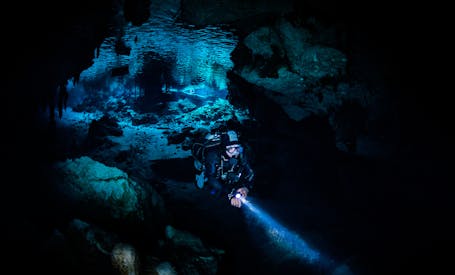
Back to the training. Note that the different agencies have different requirements and you’ll want to choose the path that is right for you. It usually comes down to which instructor you want to study under and what they teach.
Now, not necessarily required to move into the technical aspects of diving, we highly recommend going through rescue diver training and, if you’re up for it, divemaster training. The reason is that you increase your skills and abilities, increase your number of dives, and increase your ability to handle a higher level of stress while in the water. These two courses also teach you a lot about figuring out situations while underwater and working with a dive buddy to solve problems…underwater. These are key skills for anyone diving and essential skills for cave divers.
If you didn’t get your Nitrox certification earlier, it’s time to do that, and then delve into the world of tech diving. Now is the time to explore the different dive gear and reasons to use each set of specialized gear. This will help determine which courses you’ll take next. Courses include Sidemount, Advanced Nitrox, Deco Procedures, Helitrox, Extended Range, Trimix, Advanced Trimix, Rebreather (with all the associated courses under this section), and Dry suit. Once you’ve got your gear down, you’re ready to get into overhead environments.
Have you mastered buoyancy control and propulsion techniques? This can be the difference between an enjoyable dive and zero visibility - a potentially dangerous situation. Don’t be the reason someone else gets lost as silt can hang in the water for a much longer period of time than in open water situations. Practice your buoyancy control and propulsion techniques (i.e. the frog kick) until you no longer have to think about what to do in a given situation. Your behaviors should become second nature.
Why all these courses before delving into overhead environments? Well, we prefer getting all the training you can on how to navigate and use the gear and gasses before entering into a situation where you need this information.
Next up on your training regimen: Cavern, Intro to Cave, Advanced Wreck, and Full Cave. To us, these are the next minimum requirements to get started on your overhead environment experience.
Remember how we mentioned that experience is key? Well, training begets experience and how better to gain experience than with a seasoned diver (an instructor no less) keeping an eye on you and making sure you get it right. We even recommend repeating a course, if you are so inclined, with another instructor so you reap the benefits of a second perspective.
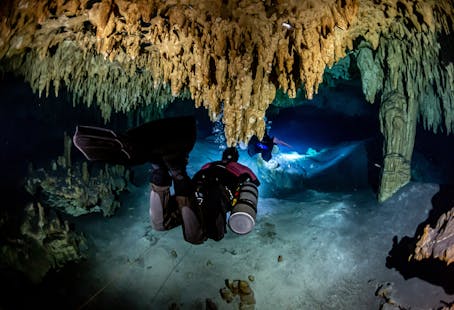
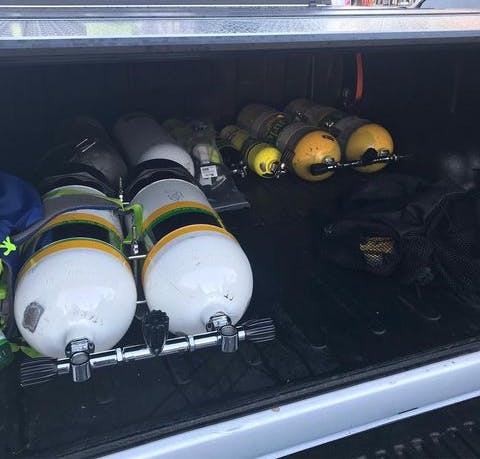
If you’re using a rebreather, there are additional courses that train you how to use this system in caverns and caves. The gear is different and comes with a unique set of benefits and risks as well as requiring a different set of skills to successfully navigate overhead environments.
While you’re at it, you may as well go ahead and sign on for Diver Propulsion Vehicle (DPV) training - you’re headed there anyway if you’re getting into serious cave diving. And more experience is good, so learning Mine, Cave Survey, Stage Cave, and Cave DPV only works for your benefit.
Keep in mind that with all this training, you also have to get out there and do the dives. If you don’t practice, you won’t remember what you learned when it matters. Start simple and as you learn new skills go practice them until you’ve got it down to the point you don’t even need to think about it before moving on to the next course.
Note that not all of the training we recommend is required; however, the more training and skills you have, the better your chances of enjoying cave diving for a long time to come. After all, this training and these skills can be all the difference in the world in that split second.
With most sports and recreational activities, we can all get ahead of ourselves and feel like we’re ready for more when we really aren’t. And with most sports, you quickly learn that you need to train more and refine your skills in a way that is quite humbling and, at times, a bit embarrassing. However, with cave diving, there is no room for ego. No room for jumping ahead and no room for errors. In this realm, errors cost lives. Split second decisions can determine whether you live to dive another day…or not. So if you’re in training and feeling held back or like you’re not advancing as quickly as you’d expected…slow your roll, check your ego, and trust your instructor.
Every scuba diver has been told many times to dive within their training…and most of us have blown it off as something the instructor has to say. However, when it comes to cave diving (and exploring any overhead environment for that matter), we strongly recommend that you heed this warning. It is of the utmost importance to dive within your training as you expand your skills and knowledge when learning how to cave dive.

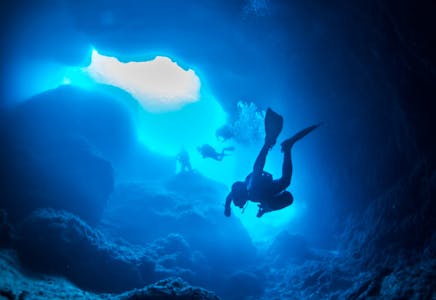
In diving terms, it’s time to head for the surface.
As you’ve read, cave diving is not for the faint of heart and requires strict vigilance, a lot of training, and specialized gear. Not only is it taxing on your body, but the gear and the training to embark on this journey can be taxing on your wallet and your relationships. And all that gear means maintenance so you won’t fall victim to gear failure when you need it to perform.
If you’re a cave diver or are interested in exploring the path of a cave diver, know that experience and training, along with the proper, well maintained gear are key to your success.
Note that this piece is not written with the intent to entice anyone into cave diving. This is an informational piece with the intent of laying out the aspects of cave diving and why some are drawn to this extreme sport.
With the deepest respect to those who cave dive, those who have been lost to the sport, and those who have lost someone to the sport, we leave you with the 5 rules of cave diving (to 100 feet):
1. Always use a continuous guideline to the surface
2. Save two-thirds of the total air supply for returning to the surface
3. Carry at least three lights during the dive
4. Limit dive depth to that appropriate for the gas you’re taking
5. Be well trained in cave diving and mentally prepared for the dive
Time for a surface interval. Safe diving.